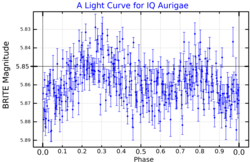
Back IQ Aurigae AST HD34452 CE IQ Aurigae Spanish آیکیو ارابهران Persian HD 34452 Italian IQ Возничего Russian IQ Aurigae Swedish HD34452 Tatar HD34452 Ukrainian 御夫座IQ Chinese
 A light curve for IQ Aurigae from BRITE nanosatellites. Plotted from data published by Strassmeier et al. (2020),[1] assuming a period of 2.463 days. | |
| Observation data Epoch J2000 Equinox J2000 | |
|---|---|
| Constellation | Auriga |
| Right ascension | 05h 19m 00.02846s[2] |
| Declination | +33° 44′ 54.2208″[2] |
| Apparent magnitude (V) | 5.38[3] |
| Characteristics | |
| Evolutionary stage | main sequence[4] |
| Spectral type | A0pSi[5] |
| U−B color index | −0.62[6] |
| B−V color index | −0.167±0.004[3] |
| Variable type | α2 CVn[7] |
| Astrometry | |
| Radial velocity (Rv) | +28.6[8] km/s |
| Proper motion (μ) | RA: +13.573[2] mas/yr Dec.: −29.028[2] mas/yr |
| Parallax (π) | 7.0526 ± 0.1065 mas[2] |
| Distance | 462 ± 7 ly (142 ± 2 pc) |
| Absolute magnitude (MV) | −0.42[9] |
| Details[9] | |
| Mass | 3.95±0.21 M☉ |
| Radius | 2.6±0.4 R☉ |
| Luminosity | 263 L☉ |
| Surface gravity (log g) | 4.34±0.12 cgs |
| Temperature | 14,454 K |
| Metallicity [Fe/H] | 1.70[10] dex |
| Rotation | 2.4660 days |
| Rotational velocity (v sin i) | 49 km/s |
| Age | 6.3[4] Myr |
| Other designations | |
| Database references | |
| SIMBAD | data |
IQ Aurigae is a (most likely) single,[4] variable star in the northern constellation of Auriga. It is visible to the naked eye as a dim, white-hued star with an apparent visual magnitude that fluctuates around 5.38.[3] The star is located at a distance of about 460 light-years from the Sun based on parallax and is drifting further away with a radial velocity of +28.6 km/s.[8]
In 1953, Sanford S Provin reported that the star, referred to at that time as HD 34452, showed indications of being a variable star, but the evidence was inconclusive.[12] Karl D. Rakos confirmed that the star is variable in 1962.[13]
This is a magnetic Ap star with a stellar classification of A0pSi.[4] It is known as a silicon star, having a strong line of singly ionized silicon, and may also be helium deficient as the lines of helium are weaker than expected.[10] The star is an Alpha2 Canum Venaticorum-type variable, ranging in magnitude from 5.35 down to 5.43 with a rotationally-modulated period of 2.4660 days.[7] It is an X-ray source with a high luminosity of 4×1029 erg s−1, which may be caused by a combination of shocks in the stellar wind and magnetic reconnection occurring well above the stellar surface. The star has been observed to flare, during which the X-ray emission rose to 3.2×1031 erg s−1.[4]
IQ Aurigae is 6.3[4] million years old and is spinning with a projected rotational velocity of 49 km/s, giving it a rotation period of 2.47 days.[9] It has nearly four times the mass of the Sun and 2.6 times the Sun's radius. The star is radiating 263 times the luminosity of the Sun from its active photosphere at an effective temperature of 14,454 K.[9]
- ^ Cite error: The named reference
Strassmeierwas invoked but never defined (see the help page). - ^ a b c d e Cite error: The named reference
GaiaDR3was invoked but never defined (see the help page). - ^ a b c Cite error: The named reference
Anderson2012was invoked but never defined (see the help page). - ^ a b c d e f Cite error: The named reference
Robrade2011was invoked but never defined (see the help page). - ^ Cite error: The named reference
aj74_375was invoked but never defined (see the help page). - ^ Cite error: The named reference
MERMILLIODwas invoked but never defined (see the help page). - ^ a b Cite error: The named reference
Samus2017was invoked but never defined (see the help page). - ^ a b Cite error: The named reference
Gontcharovwas invoked but never defined (see the help page). - ^ a b c d Cite error: The named reference
aaa334_181was invoked but never defined (see the help page). - ^ a b Cite error: The named reference
aa_9_380was invoked but never defined (see the help page). - ^ Cite error: The named reference
SIMBADwas invoked but never defined (see the help page). - ^ Cite error: The named reference
Provin1953was invoked but never defined (see the help page). - ^ Cite error: The named reference
Rakos1962was invoked but never defined (see the help page).